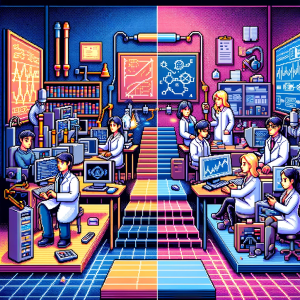
Why Some Happy Workers Slack Off—And What Makes Others Thrive
We’ve all worked with that person—you know, the one who seems genuinely cheerful every day, loves the job, brings cookies to team meetings… and somehow doesn’t quite get anything done. Meanwhile, there’s the moody wizard who grumbles through the day but hits every deadline like clockwork.

So here’s the million-dollar question: Is being happy at work actually linked to being productive?
Turns out, science has been wrestling with this idea for decades. It even has a name: the Happy-Productive Worker Thesis. But new research out of Colombia just shook things up with a twist: happiness and productivity don’t always go hand in hand—and your age and gender might tip the scale.
The Classic Myth of the Smiling Overachiever
Let’s back up for a second. The Happy-Productive Worker Thesis (HPWT for short) has been kicking around since the 1930s. It’s the idea that a happy worker is a productive worker, and if you want better performance, boost morale. Cue ping-pong tables, free snacks, and “Motivation Monday” memes.
And hey, there’s truth to it. Plenty of studies show that happy people tend to work harder and perform better.
But then—plot twist—not every study agrees. Some show barely any link at all. Others suggest unhappy people can be just as productive (hello, tortured genius trope). So what’s really going on?
That’s where this new study steps in.
Not One, But Three Types of Workers
Researchers in Colombia surveyed 504 full-time workers and their bosses. They weren’t just checking if someone felt happy or if they were seemed productive. They looked at both job satisfaction and how supervisors rated performance.
They didn’t find just one kind of worker—they found three distinct groups:
- 🟢 Happy and Productive: These folks love their jobs and crush their tasks. Basically the gold standard.
- 🟡 Happy but Unproductive: They enjoy their work but just don’t get much done.
- 🔴 Unhappy and Unproductive: Oof. Not great on either front.
And what’s missing? That mythical grumpy-but-effective worker. Apparently, that combo didn’t show up when supervisors were calling the shots. (Self-rated studies find them sometimes—but maybe we’re just flattering ourselves?)

So What Makes Someone Happy AND Productive?
Here’s where things get juicy. The researchers dove into what kind of jobs each group had—and what kinds of people they were.
For the happy-and-productive crowd, two things stood out:
- 💬 Social support: They felt connected and supported by coworkers.
- ❤️ Task significance: They believed their work mattered.
That combo—feeling like your job means something and having people in your corner—is a one-two punch for workplace awesomeness.
Surprisingly, other things like autonomy, job complexity, and using fancy equipment didn’t always help. In fact, too much of those could backfire. Think of it like seasoning: a little autonomy adds flavor, too much and you’re drowning in salt.
Men, Women, and the Happy-Productive Equation
Here’s where it gets even more fascinating: gender plays a role in what makes someone thrive.
For men, being productive and happy often came with:
- Problem-solving challenges (they liked figuring things out)
- Social support (yes, guys need it too!)
- Simpler tools (less complex equipment = less frustration)
For women, the secret sauce included:
- Feeling their work had impact
- Opportunities to specialize and build expertise
- Also, social support (across the board, that was key!)
So while both genders valued relationships at work, the path to peak performance wasn’t exactly the same.
Age Isn’t Just a Number—It’s a Workstyle
Age was another curveball. Different generations wanted different things from their work.
- 👵 Older workers thrived when they had meaningful jobs, strong social ties, and less nitpicky feedback. They didn’t need constant praise—they needed purpose.
- 👨🦰 Middle-aged workers wanted jobs that mattered but didn’t overwhelm them. Think meaningful without chaos.
- 🧑💻 Younger workers craved significance too, but also leaned heavily on social support and clear structure. Less autonomy actually worked better for them—likely because they’re still learning the ropes.
This adds a new layer to how we think about younger employees struggling in their early careers. It’s not always about lack of ambition—they might just be in the wrong job setting.
So What’s the Big Takeaway?
Let’s ditch the one-size-fits-all approach to “engagement.” This study shows that what makes a worker both happy and productive is personal—shaped by gender, age, and specific job traits.
Want to help someone thrive at work?
- Don’t just offer more freedom. Offer meaning.
- Make sure people feel connected.
- Recognize that younger employees might need more structure, while older ones may want more purpose and less micromanagement.
It’s not about perks—it’s about design. A well-crafted job beats a pizza party any day.
Let’s Explore Together 🧠✨
What does your “happy-productive” look like? Jump into the comments or tag us on social media to share your take.
- How do you see this research affecting your work or team?
- What work trait most motivates you—social support, task significance, or something else?
- What’s the weirdest job that ever made you feel truly satisfied?
👇 Share your thoughts below—and don’t forget to send this to your favorite work buddy or HR manager!
Unlock Science Secrets:
Science is under threat, and your knowledge is your power. This Week in Science offers groundbreaking insights, revolutionary research, and transformative discoveries to arm you with the facts in an increasingly polarized world. Our free weekly newsletter is perfect for educators and science lovers alike. Don’t wait—subscribe now to deepen your understanding and stand with science. If you liked this blog, please share it—your referrals help us keep science accessible to everyone.



